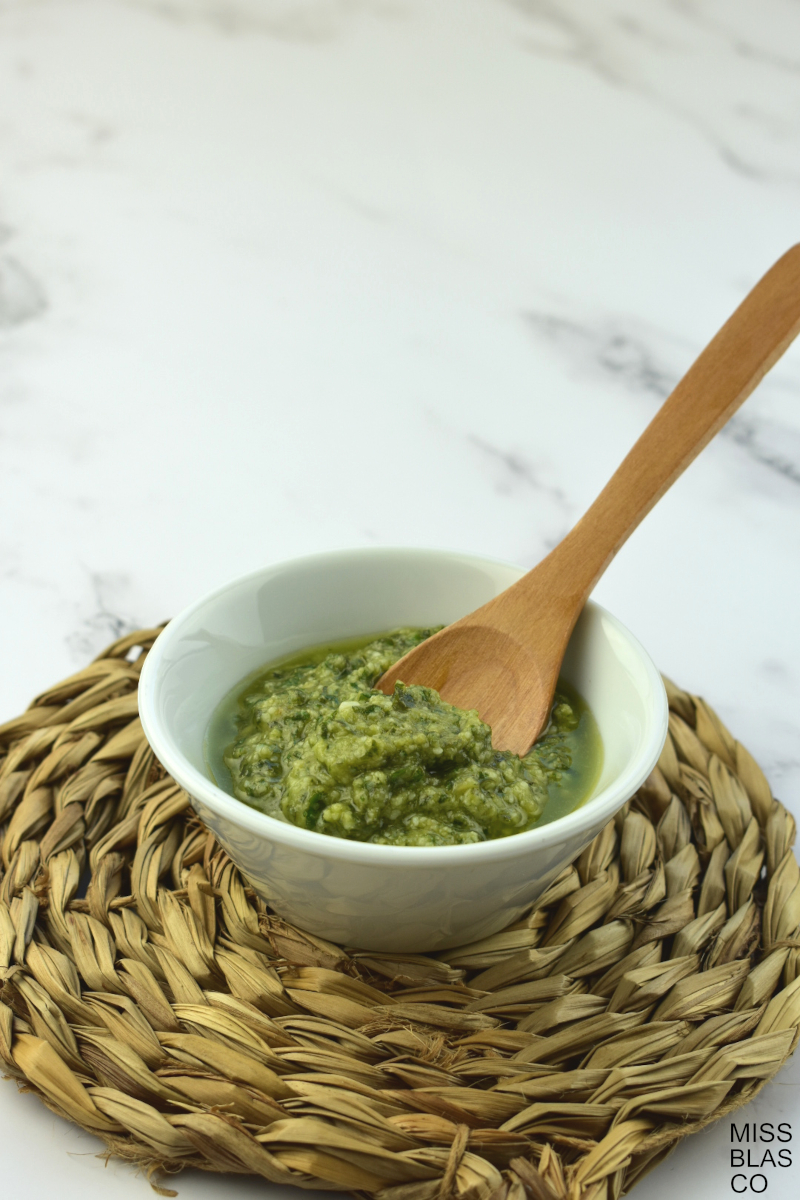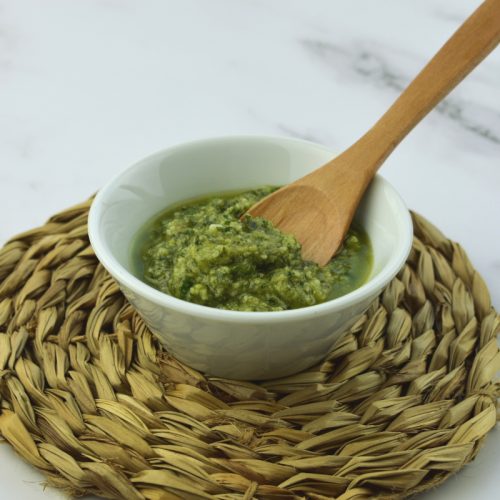
PESTO EN 10 MINUTOS
Preparar una salsa pesto es facilísimo, deberás invertir como mucho 10 minutos y el resultado es espectacular.
Esta vez quiero compartir un pesto de albahaca, trato de que se parezca a la original cuyo origen está en Liguria (Italia), pero seguro que alguien de allí tendría alguna objeción, ¡es natural!.
Pero, ¿Qué es el pesto?, el pesto es un majado, una salsa que tradicionalmente se prepara en un mortero, y que combina diferentes ingredientes machacados a mano.
Lo principal para hacer un buen pesto casero es la albahaca, yo tengo unas plantas en casa, pero siempre puedes comprar un buen manojo en el mercado.
El otro ingrediente que hace de esta salsa algo muy especial son los piñones, vas a encontrar versiones hechas con almendra o cualquier otro fruto seco, pero la salsa original lleva piñones.
Los piñones le dan un toque muy especial, sabor y textura un poco cremosa por tratarse de un fruto oleaginoso, sus propiedades nutricionales hacen de ellos un alimento a tener en cuenta.
Tip: Si los tuestas un poquito antes de incorporarlos a la salsa, su sabor y aroma se intensifican.

Propiedades nutricionales de los piñones:
- Son semillas, aunque los consideramos frutos secos.
- Aportan grasas, son frutos oleaginosos, ricos en ácidos grasos poliinsaturados y monoinsaturados.
- Ricos en potasio, fósforo y magnesio.
- Son bajos en carbohidratos.
- Bastante calóricos (683 kcal/100g), pero teniendo en cuenta que esas calorías proceden de grasas saludables y que se consume poca cantidad, no es un problema.
Un buen pesto debe llevar piñones, parmesano y las mejores hojas de albahaca fresca que puedas encontrar.
Otro ingrediente fundamental en un buen pesto es el queso parmesano, le da un sabor increíble, procura comprar uno bueno, un parmesano de verdad, porque el sabor es muy diferente, mucho más profundo y con más matices.
Y por supuesto ajo, al gusto, no hay una medida exacta porque depende de las proporciones del resto de ingredientes, ocurre lo mismo que con otras salsas, si te gusta más potente, pon más, si lo quieres más suave, menos.
Un buen chorro de aceite de oliva virgen extra y un poco de sal, como el parmesano es un queso bastante salado, mejor no pasarse.
Tradicionalmente el pesto se hacía en un mortero, a mano, ahora es habitual hacerlo en un robot de cocina eléctrico, a mi me gusta usar uno no demasiado potente y darle pulsaciones intermitentes para conseguir que la salsa tenga textura.
No tiene que quedar líquida, es mucho más agradable notar los pequeños trocitos de piñón, de queso, etc.
El pesto de albahaca es el tradicional, pero también está exquisito el pesto rojo, que se prepara con tomates secos en vez de albahaca.
Ambos son salsas deliciosas que mejoran cualquier plato, no dudes en probarlas si todavía no lo has hecho.

Algunas maneras de consumir pesto de albahaca:
- Con un buen tomate
- Ensalada de tomate y mozzarella
- Espaguetis de calabacín
- Tomates rellenos
- Pasta con pesto
- Como salsa para acompañar pescado
Puede que te interese:
- 5 RECETAS DE VERANO SALUDABLES.
- ENSALADA GRIEGA
- ENSALADA DE NABO LOW CARB
- ENSALADA DE PEPINO LOW CARB

PESTO EN 10 MINUTOS
Ingredientes
- 60 g hojas de albahaca fresca limpias y secas
- 1 cda piñones tostados
- 1/2 diente de ajo
- 1 pizca sal marina
- 2 cda aceite de oliva virgen extra
- 50 g queso parmesano
Instrucciones
- Introduce todos los ingredientes en un robot de cocina que pueda funcionar a baja potencia y por impulsos. También puedes machacarlo a mano en un mortero.
- Sirve la salsa y adereza con ella lo que más te guste, yo la suelo usar para aliñar un buen tomate con mozzarella o para preparar unos zoodles al pesto.
Notas
- Las hojas de albahaca es conveniente lavarlas y secarlas con papel de cocina, desecha los tallos.
- Debes tostar los piñones en una sartén a fuego bajo, con cuidado de que no se quemen.
- Es aconsejable no añadir todo el aceite al principio, mejor añade una parte al final hasta obtener la textura deseada.
- En cuanto a la sal, no especifico la cantidad porque el queso parmesano es muy salado y no vas a necesitar mucha, prueba y ajusta a tu gusto.
- Si haces la salsa en un robot, ten en cuenta picar poco a poco, con impulsos cortos, y a baja potencia, no hay que obtener una salsa líquida, deben quedar pequeños "tropezones".
- Tradicionalmente esta salsa se hace a mano en un mortero.
¡Suscríbete a la newsletter y mejora tu dieta ya!